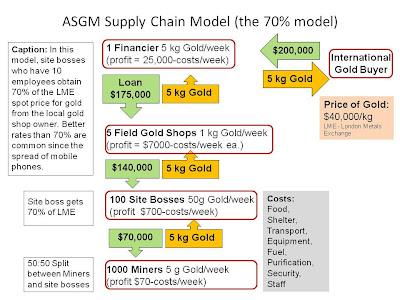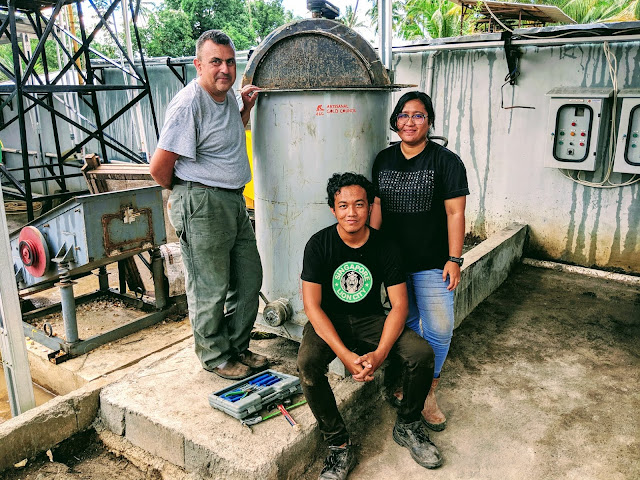Fifty thousand gold shops in the world's artisanal gold supply chain
There are approximately 50,000 small gold shops serving artisanal and small scale gold miners worldwide. They are a doorway to engaging artisanal gold mining communities and they are the first link of many in the artisanal gold supply chain to consumers.
by Kevin Telmer, Artisanal Gold Council
Gold shops and the supply chain
Small informal gold shops are common in artisanal and small scale mining communities. After the miners, they are the next link downstream in the informal gold supply chain. They process raw gold or gold-mercury amalgam and then buy the raw gold product from miners at a price that is typically based on the London fix. This price is well known by both the miners and the shop owners due to mobile phones. Some shop owners will also refine the gold to close to 24 k purity (>99%) before selling it to the next level up in the supply chain. This is often done using the quartering technique which involves creating an alloy with silver and then digestion in nitric-acid to separate the gold from impurities such as copper. Others will assess the gold content (often by the difference of weight-in-water and weight-in-air) and then sell the raw product (gold dore) based on its percentage of gold. Gold from shops moves downstream in the supply chain to regional buyers and financiers and eventually to an international dealer and into the international marketplace as jewelry or bullion. Below is a model called the 70% model illustrating how 1000 miners interact with 5 gold shops and 1 financier and the international market.
Figure adapted from Telmer K. (2011, May 4) Lecture presented at the first meeting of the OECD hosted working group on gold. "OECD due diligence guidance for responsible supply chains of minerals from conflict affected and high-risk areas. Presentation at: http://bit.ly/lQB1hE.
Gold shops as communication nodes
Because one gold shop communicates with many miners, shops can serve as focal points for establishing relationships and lines of communication with mining communities. They can be nodes through which to deliver education on issues like health, better mining and environmental practices, and formalization/legalisation approaches. How many gold shops there are worldwide is therefore an important question when considering how to distribute information or provide assistance.
Number of gold shops
by Kevin Telmer, Artisanal Gold Council
Gold shops and the supply chain
Small informal gold shops are common in artisanal and small scale mining communities. After the miners, they are the next link downstream in the informal gold supply chain. They process raw gold or gold-mercury amalgam and then buy the raw gold product from miners at a price that is typically based on the London fix. This price is well known by both the miners and the shop owners due to mobile phones. Some shop owners will also refine the gold to close to 24 k purity (>99%) before selling it to the next level up in the supply chain. This is often done using the quartering technique which involves creating an alloy with silver and then digestion in nitric-acid to separate the gold from impurities such as copper. Others will assess the gold content (often by the difference of weight-in-water and weight-in-air) and then sell the raw product (gold dore) based on its percentage of gold. Gold from shops moves downstream in the supply chain to regional buyers and financiers and eventually to an international dealer and into the international marketplace as jewelry or bullion. Below is a model called the 70% model illustrating how 1000 miners interact with 5 gold shops and 1 financier and the international market.
Figure adapted from Telmer K. (2011, May 4) Lecture presented at the first meeting of the OECD hosted working group on gold. "OECD due diligence guidance for responsible supply chains of minerals from conflict affected and high-risk areas. Presentation at: http://bit.ly/lQB1hE.
Gold shops as communication nodes
Because one gold shop communicates with many miners, shops can serve as focal points for establishing relationships and lines of communication with mining communities. They can be nodes through which to deliver education on issues like health, better mining and environmental practices, and formalization/legalisation approaches. How many gold shops there are worldwide is therefore an important question when considering how to distribute information or provide assistance.
Number of gold shops
A first estimate based on observations from field work by the many authors listed in Telmer and Veiga (2009) and kept up to date on the www.mercurywatch.org database, is as follows:
At 50,000 gold shops worldwide, emission controls could make a rapid and major contribution to reducing mercury pollution. Several groups are doing this. For example, the Artisanal Gold Council in collaboration with the European Environmental Bureau and AGENDA are running a mercury emissions reduction program in Tanzania, and the USEPA, Blacksmith Institute and Yayasan Tambuhak Sinta are beginning a program in Indoneisa; and UNIDO and the USEPA have run programs in south America.
At 10 million ASGM miners with a gold production of 350 tonnes/year (Telmer and Veiga, 2009), if each gold shop serves 200 miners, as noted in reports to UNIDO's Global Mercury Project and in compliance with the 70% model described above, then there are roughly 50,000 gold shops that process about 7 kg of gold per year worldwide (total gold value of $338,000/a/shop at 2011 price of $1500/oz). There is of course variation in the number of miners served by each shop but nonetheless, it is clear that there are tens of thousands of gold shops.
Gold shops and mercury pollution
The number of shops is also helpful for assessing environmental impacts caused by artisanal mining and how to implement and prioritize solutions to reduce them. For example, gold shops can be large point sources of mercury emissions to the atmosphere because they evaporate mercury-gold amalgam to retrieve the gold. They can therefore be very good places to install emission controls as a first step to lower mercury pollution. A longer term goal can be mercury free processing of gold ores, but transitioning to zero mercury use can require substantial shifts in socio-economic systems, training, capital investment, legal procedures, etc., and therefore take a long time. While the transition to zero mercury is occurring, emission controls offer an immediate reduction in mercury pollution, and an opportunity to build a positive relationship with the community. Step 1 - lower mercury; Step 2 - zero mercury.At 50,000 gold shops worldwide, emission controls could make a rapid and major contribution to reducing mercury pollution. Several groups are doing this. For example, the Artisanal Gold Council in collaboration with the European Environmental Bureau and AGENDA are running a mercury emissions reduction program in Tanzania, and the USEPA, Blacksmith Institute and Yayasan Tambuhak Sinta are beginning a program in Indoneisa; and UNIDO and the USEPA have run programs in south America.




green scientists are more running on to a serious issue in protecting earth, because time is very less. we need a revolutionary idea for that.
ReplyDeleteHouston Gold Merchants
Hello, I was very encouraged to locate this website. The reason currently being that this is these kinds of an useful post. I wished to thank you for this useful read of the topic.
ReplyDeletesell gold Houston
gold buyers in Houston
nous n'utilisons pas de mercure à Madagascar, on cherche des acheteurs internationaux, pour que l'on aura une stabilité de prix et de marché, les investisseurs en extraciton aurifère ne sont professionnels, il nous faut de la formation, des équipements, pour devenir compétitifs
ReplyDelete